








Welcome to another special edition of Teen Ink magazine. With articles ranging from finances to finding oneself, this issue shares teens’ thoughts on all things college!
We know graduation is approaching for some of you, so we would like to let you know how grateful we are that you’ve spent time sharing your talents with Teen Ink! Whether you’ve used Teen Ink to build your portfolios or just as an outlet for expression, we can tell you are going to do great things. We are wishing a HUGE congratulations to everyone graduating this year!
And don’t forget, the Teen Ink Educator of the Year 2023 contest winners are announced in this issue, along with the winners of two other contests!
As always, we welcome your feedback! If you want to write a letter to an editor, respond to an opinion article, or just take a stab at creating a poem good enough to make it into our next magazine, visit teenink.com/submit!
Best wishes! The Teen Ink Team

“The beautiful thing about learning is that no one can take it away from you.”
—B.B. King


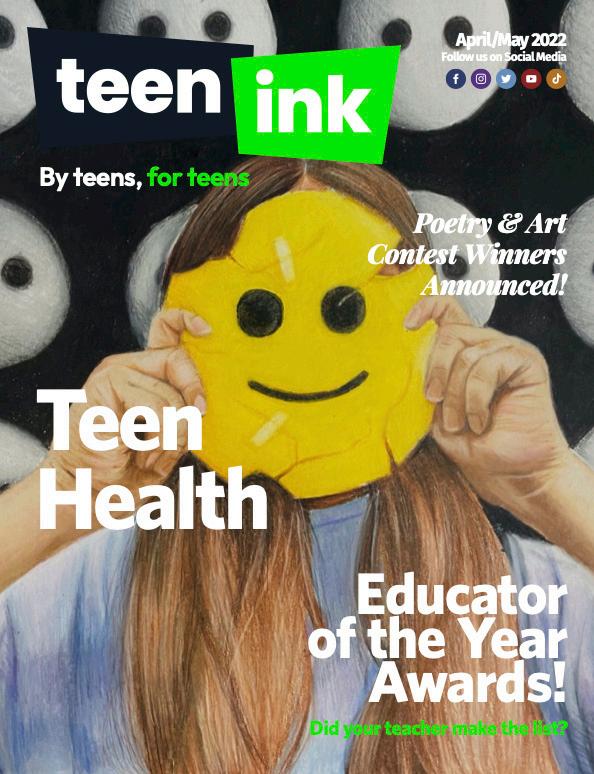
In an effort to slow the spread of Covid-19 in 2020, the spring and summer SAT and ACT tests were canceled. These issues prompted many colleges throughout the nation to go test-optional, meaning that applicants were not required to submit their standardized test scores. Students across the nation collectively sighed in relief.
“We have been considering going test-optional for a few cycles now,” Christian Burnett, the assistant dean of admissions at William & Mary, said. “We decided we could not require students to submit something they either didn’t have access to, or took while under extreme circumstances, such as during a pandemic.”
It makes sense that colleges went test-optional in light of the pandemic — but should they permanently implement this application policy? Yes. Yes, they should.
Colleges claim that the purpose of standardized tests in college admissions is to provide an objective measure of a student. Theoretically, a high SAT or ACT score shows that the student is
ready to handle a challenging college course load. But, this is not necessarily true.
In an article published by PBS, William Hiss, the dean of admissions at Bates College, shared information about his study comparing the college GPAs of students who
submitted their test scores and those who took advantage of a test-optional policy. He found that there was only a .05 discrepancy between the two groups. Conclusively, test scores are not indicators of college success.
Course rigor and class grades in high school are more accurate indicators of how a student will do in college. If a student took the most challenging classes available to them at their high school and earned perfect — or nearly perfect — grades, this shows their diligence. It may not necessarily indicate their intelligence, but why does that matter? Having a lower IQ should
not keep you out of college. In fact, it should show a college that you are an engaged student, who is willing to do anything it takes to succeed.
“A successful W&M (Willam & Mary) applicant is strong in all areas, both academic and extracurricular,” Burnett said. “As such, a student who typically had higher scores also had a higher GPA or more rigorous course load. Therefore, the caliber and level of student excellence shouldn’t change significantly.”
In addition, rigorous high school courses, such as Advanced Placement or International Baccalaureate, allow students to gain the skills and strategies necessary to succeed in college courses. For example, in high school, students have to budget their time, collaborate with their peers, and develop organizational skills. Standardized tests assess completely different abilities that are irrelevant in college and beyond. In fact, an SAT reading strategy that experts recommend is skipping over the passage and going straight to the questions. Your college English professor would frown upon that.
Not only do colleges want students who are going to be successful in their courses, but they also want students who will make a difference in the world. They claim that
A STUDENT WILL DO IN COLLEGE
students should show passion and achievement. Implementing a test-optional policy would prove that is really their priority.
“Colleges are looking for students who care — about people, about communities, about the subjects they study,” Allison Tate, a college admissions consultant, said. “It’s not about gaming your GPA or checking off boxes on an app. It’s about figuring out who you are and where you will thrive and grow and become the person you are meant to be, not the person you think colleges are looking for.”
This makes sense. Genuine interest and dedication shows colleges a student’s intrinsic motivation, which will remain well into their future. Standardized tests, on the other hand, are not always an accurate representation of career success.
“The human mind is simply so complex and so multifaceted and fluid, that trying to find a single measurement tool that will be reliable across the enormous populations of American students is simply a trip up a blind alley,” Hiss said when talking to PBS. “I would never say the SATs and ACTs have
GENUINE INTEREST AND DEDICATION SHOWS COLLEGES A STUDENT’S INTRINSIC MOTIVATION, WHICH WILL REMAIN WELL INTO THEIR FUTURE
no predictive value for anybody; they have predictive value for some people. We just don’t find them reliable cross populations.”
Almost no student in their right mind would take the ACT for fun. Most students are extrinsically motivated by the desire to get into college. Students either have to study over summer break, or cram it
into the school year while juggling class work and extracurriculars. With permanent test-optional policies, teens wouldn’t have to spend as much time preparing. They could spend their spare time on activities they genuinely enjoy.
“High school students need to think about what they want out of high school, out of college, and out of life,” Tate said. “This pandemic has forced all of us to recognize the fragility of life and question how we spend our time. Pursue interests you actually love, things that make you excited about getting up every day. Take classes that are hard for you and figure it out. Learn. Connect. Read books.”
Not only will this free up time for teens to pursue activities they love, it will also be better for their future. Spending the summer conducting research or exploring the arts instead of studying may help a student shape their interests, or prepare for their career.
Aside from all of its merits, there is one problem that arises with the idea of a test-optional system: schools throughout the country are inconsistent on how leniently they grade students. This is why schools have previously put more emphasis on other aspects of the application, such as test scores. But Tate, who has years of admissions consulting experience, believes that schools will find other ways to assess students fairly — test or no test.
“I think that if schools continue to be test-optional, they will need to ask for more writing from students — grade inflation and discrepancies are a big problem in our high schools,” Tate said.
Although colleges with testoptional policies will no longer be able to rely on the SAT and ACT as a consistent measurement of students, focusing on other aspects of the application will help them identify the
deserving applicants.
“I do not think it will affect admissions at elite schools very much — I think they will rely on teacher recommendations and essays to corroborate GPAs, and though it might be a more tedious slog without the additional information, they will likely end up with similar outcomes as they would have with test scores,” Tate said.
COLLEGES WITH TEST-OPTIONAL POLICIES WILL NO LONGER BE ABLE TO RELY ON THE SAT AND ACT AS A CONSISTENT MEASUREMENT OF STUDENTS, FOCUSING ON OTHER ASPECTS OF THE APPLICATION WILL HELP THEM IDENTIFY THE DESERVING APPLICANTS
At this point, some universities throughout the nation are doing a test-optional trial run for three years. Many are unsure whether or not this policy will continue after the trial.
“This way not only are we ensuring that current juniors and sophomores who were affected by COVID are given a fair application process, but we can also build a full cohort on campus to see how being test-optional changes our academic makeup,” Burnett said.
The coronavirus has sparked changes in our world, and test-optional policies are a positive change worth keeping. Colleges, make it happen. Go test-optional. Permanently.
We had the ACT yesterday. The room felt really cold — almost too cold to be in, like Antarctica. Was it really that cold, or was I just nervous about the test? I settled down in my seat along with the other 25 test takers, and the ACT officially began. There were three tests in particular that had me thinking deeply, even after I got home. These challenging sections were math, writing, and science. The strange part about the three was that the math
THE STRANGE PART ABOUT THE THREE WAS THAT THE MATH PORTION WENT TOO FAST, BUT THEN THE WRITING AND SCIENCE PORTIONS WERE SUPER SLOW
portion went too fast, but then the writing and science portions were super slow.
I didn’t like that at all. After all, this was my first ACT, and I thought I had prepared myself pretty well. Anything can happen when taking a test like this, right?
Out of the three tests that stuck to my brain like hard cement, math was first. I was confident about math for a couple of reasons. I am in an advanced math class. My strongest subject is math. The
ACT math portion is spread from geometry and up. All of these reasons made me think that I was going to be okay. There were 60 math questions. When I thought my pacing was good, I checked the time and had 20-25 minutes to answer 25 questions. My pace was a question every minute, but once you reached the long questions that you had to write out, that one question per minute pace kind of just went down the drain. So, within the last five minutes, I had to guess on eight questions. I was a little disappointed about that, but these were educated guesses, and this was my first ACT. I didn’t really know what to expect.
Chemistry and writing were long tests. It felt like you were lying in bed all night trying to sleep, constantly checking the time, only to see it had moved four minutes, not two hours. I finished the last chemistry question with 30 seconds to spare. My eyes were slowly starting to shut. Even the coldness in the room wasn’t enough to keep me awake. I also knew for a fact that this was one of the hardest subjects for me to understand.
Writing, however, took another step down the extremely long-time stairs. This was the final test on the ACT.
Everybody was eyeing the clock. The second the bell rang, Black Friday-like chaos was going to erupt, and everyone was going to sprint to their cars. It was really that bad.
I ended up writing a little over two pages in around 25 minutes. I reread my paper a few times over and made some simple mistake fixes. Once I finished, the rest of the time stretched on for eternity. Closing my eyes didn’t work. Playing with my calculator didn’t help. I just had to hopelessly sit there and not look around too much or else the teacher would think I’m cheating. I was just endlessly sitting there.
I expected the ACT to be long the first time, but I personally thought that this was one of the longest tests of my life. I will be taking this test a couple more times. I will need to prepare a little more and make sure I get even more sleep, because I thought seven hours was enough. Who knows, though — I could take this test again and do so much better than what I originally thought, but with the same, or even less preparation. That is what I hope. ‘Til next time.
SECOND THE BELL RANG, BLACK FRIDAYLIKE CHAOS WAS GOING TO ERUPT, AND EVERYONE WAS GOING TO SPRINT TO THEIR CARS
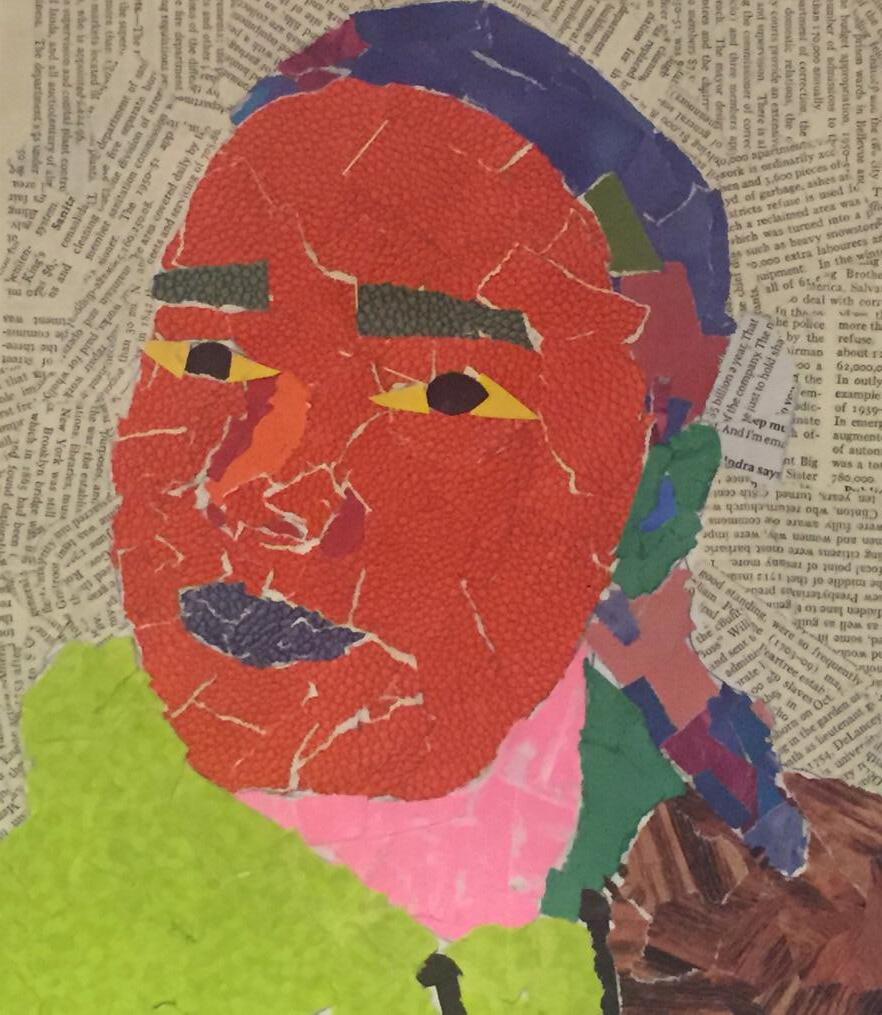



San Ramon, CA
BY ANJANI LAL, SAN RAMON, CAHigh school isn’t exactly like the movies. There are no impromptu song breaks in the cafeteria, no bullies shoving people into lockers, and certainly no dance battles between cliques. Yet for all their discrepancies, one aspect that high school movies nailed was the effect a teacher can have on a student. It’s an archetype we’ve all seen before: with every comingof-age film comes a benevolent teacher leaving a lasting impact on their pupils. However, this impact was something that I only became personally acquainted with after meeting Mr. K.
When I began freshman English, it quickly became obvious Mr. K wasn’t a conventional teacher. With his curriculum, long gone were the days of writing formulaic essays and reports. Instead, they were replaced with enriching activities like animations about books we read, argumentative letters to administrators, and videos we directed ourselves. Although this seemed unusual at first, I soon realized that Mr. K’s methodology fostered a distinct feeling of fulfillment. At the end of every unit, I got to watch with pride as my projects came to fruition. In Mr. K’s classroom, I wasn’t just a student. I was an inventor, director, and creator. I was someone with the opportunity to transcend the limits often imposed on my potential.
As the school year progressed, Mr. K proved he’d let our voices be heard. The signs of it were evident in his classroom: The list of our rights hanging on the wall. The votes we held to make important decisions. And

— the one I appreciated most as a woman of color — our class discussions about equality. Everywhere I looked, I was reminded that Mr. K wouldn’t just let me know what my rights are, but advocate for them as well. I found that there’s a simple comfort in knowing that no matter what, someone was on my side, ready to stand up for me.
The most heartwarming detail about Mr. K was that he genuinely cared about our mental health. He often hosted wellness days where I could take a step back, put the world on hold, and check in with myself. Even better, he accommodated for the fact that high school is a torrential flurry that can easily spin out of control. I can’t count how many times Mr. K’s extended deadlines saved me from losing hours of sleep. How many times taking deep breaths as a class bought me an extra moment of respite. How, in the little ways, Mr. K helped me manage the ups and downs of growing up.
At the end of the day, high school truly is nothing like the movies. Real life is far more overwhelming, sometimes even disastrous, and doesn’t even have any dance battles to make up for it. But teachers like Mr. K help me turn it all — the whirlwinds, the stress, the chaos — into something I can tackle head-on. They make school a community I feel welcome to be a part of.
Thank you, Mr. K.
In freshman year, I became captive to nicotine addiction. I found that through vaping, I could gain companionship, popularity, and a few moments of seemingly pure bliss. I was popular. I never found myself having no one to talk to or nothing to do after school. With a vape in my hand, I felt needed and important. For two years, this crowd I ran with was the most important thing in my life. Yet, something about me was different from them. I wasn’t as fearless as them. I wasn’t as confident. So, I got into fights, skipped school, and ended up being suspended. Twice. I remember thinking that that was as great as my life would ever get.
Now, as a junior, I understand that I mistook fearlessness for a lack of discipline and confidence as a mask to hide my misery. The crowd I ran with was fueled by self-hatred, addiction, and egocentrism. My popularity would end come graduation. The too few moments of seemingly pure bliss would become harder to come by, and I’d kill myself chasing it. The companionship I had had always been conditional and ran out when I had nothing more to offer than myself. Mrs. Blasi helped me realize this.
Mrs. Blasi taught my sophomore creative writing class. I joined the class due to my love of books and interest in writing. She saw something in me. Not with a vape in my hand or with my fists curled. She saw something in me — purely me.

Mrs. Blasi encouraged me to quit vaping. She assured me that I could do it, even when it seemed impossible. When I cut my friends out and suddenly had no one to sit with at lunch, her door was always open. When I was diagnosed with depression — not long after — she was my only confidant.
I have been sober for a year and I owe it to Mrs. Blasi — my teacher of the year — as much as myself.
I can recall the days that I stayed with Mrs. Blasi after school to write a contest submission for a local teen arts festival, a high fantasy short story. Adults don’t exactly approve when I tell them of my fantasy writing aspirations. Mrs. Blasi, however, has been my greatest supporter and teacher as I’ve been writing my novel. She gives me the strength to look the world straight in the eye and be confident in who I am and what I love.
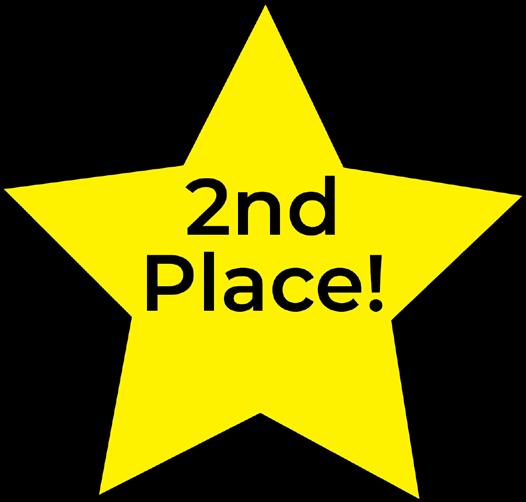
When I think back to how I once thought that failing classes, sitting on the floor of a bathroom stall, and passing a vape around was the best my life would get, I want to cry.
I want to cry tears of joy that I met Mrs. Blasi. I want to thank her for saving me, for showing me that I have so much yet to accomplish in life, and for always encouraging my passions. I will forever be grateful that she saw something in me — purely me.
“Smaller equals faster.” This was the sophomore year mantra that led me to lose tens of pounds that I shouldn’t have. I thought that I was helping myself, and everywhere I looked, my addiction to dropping numbers was reaffirmed as discipline.
A few weeks into my first varsity cross country season, Coach Kaczor asked to speak with me after practice. On a wooden bench in the athletic wing, he said the words that propelled me into recovery — “I’m worried about you.”
Him telling me that my weightloss was becoming detrimental to my well-being completely cracked the foundation that I had built my eating disorder upon. Here was someone whose job it was to make me a better runner, who was also wanting me to gain weight.
It seemed like an oxymoron. But I took it to heart anyway.
The following season, we both had high hopes for what I could achieve while actually being healthy. He was pushing me, assigning faster paces than I thought I was capable of. Sometimes I hit them, but with others, I panicked under my fear of failing.
Regardless of the situation, he always knew when to push and when to back off.
It’s not an easy job to train teenagers to run, but he excels at it by taking a holistic approach to coaching. He understands that in order to perform at our best, our mental and physical health must be a priority.
Coach Kaczor made this clear by encouraging the team to communicate anything holding us back from running our best, even though this meant a lot of pre-practice and postpractice conversations.
Although it meant overtime for him, Coach made every chat feel important and somehow always offered the right response. Many afternoons he eased my anxiety about upcoming races with personalized advice and race strategy. Sometimes he just pulled me out of my head with the words, “Lexie, it’s running. You do it everyday.”
Prior to my best race of my senior year he said my favorite line of all: “Run the race that we both know you’re capable of.”
I didn’t get an all-time personal record that day, but I ran the whole 5K smiling and managed a season personal record. Coach Kaczor greeted me at the finish like I ran an Olympic trial’s qualifying time: “You did it! You were amazing!”

He has always been there to celebrate the wins of everyone on the team, no matter how small.
It wouldn’t be fair to talk about Coach Kaczor without also mentioning his other commitments as a third grade science teacher and a dad to two little girls. Occasionally, his daughters would accompany him on our Saturday morning practices, and for the past two years they hand-picked apples for the whole team to enjoy. Naturally, we’re all their biggest fans and get almost as excited as Coach when one of them has an assist to the winning goal of their soccer game.
I’m so grateful to have trained with such a thoughtful, inspiring coach for the past three years. In addition to showing me what it takes to be a great runner, Coach Kaczor taught me to believe in myself. I hope that everyone gets the opportunity to meet such an outstanding role model in their lifetime.
He understands that in order to perform at our best, our mental and physical health must be a priority
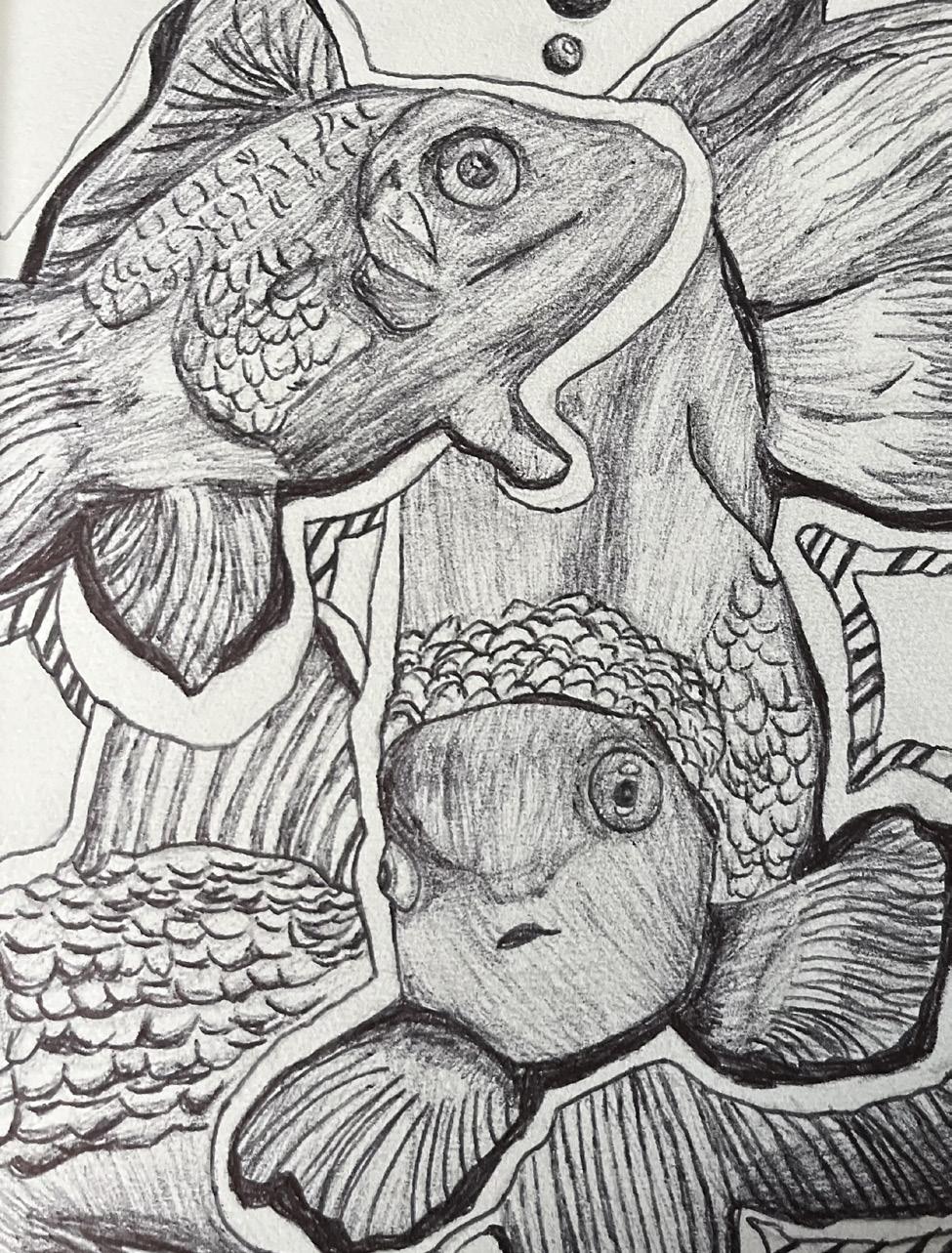
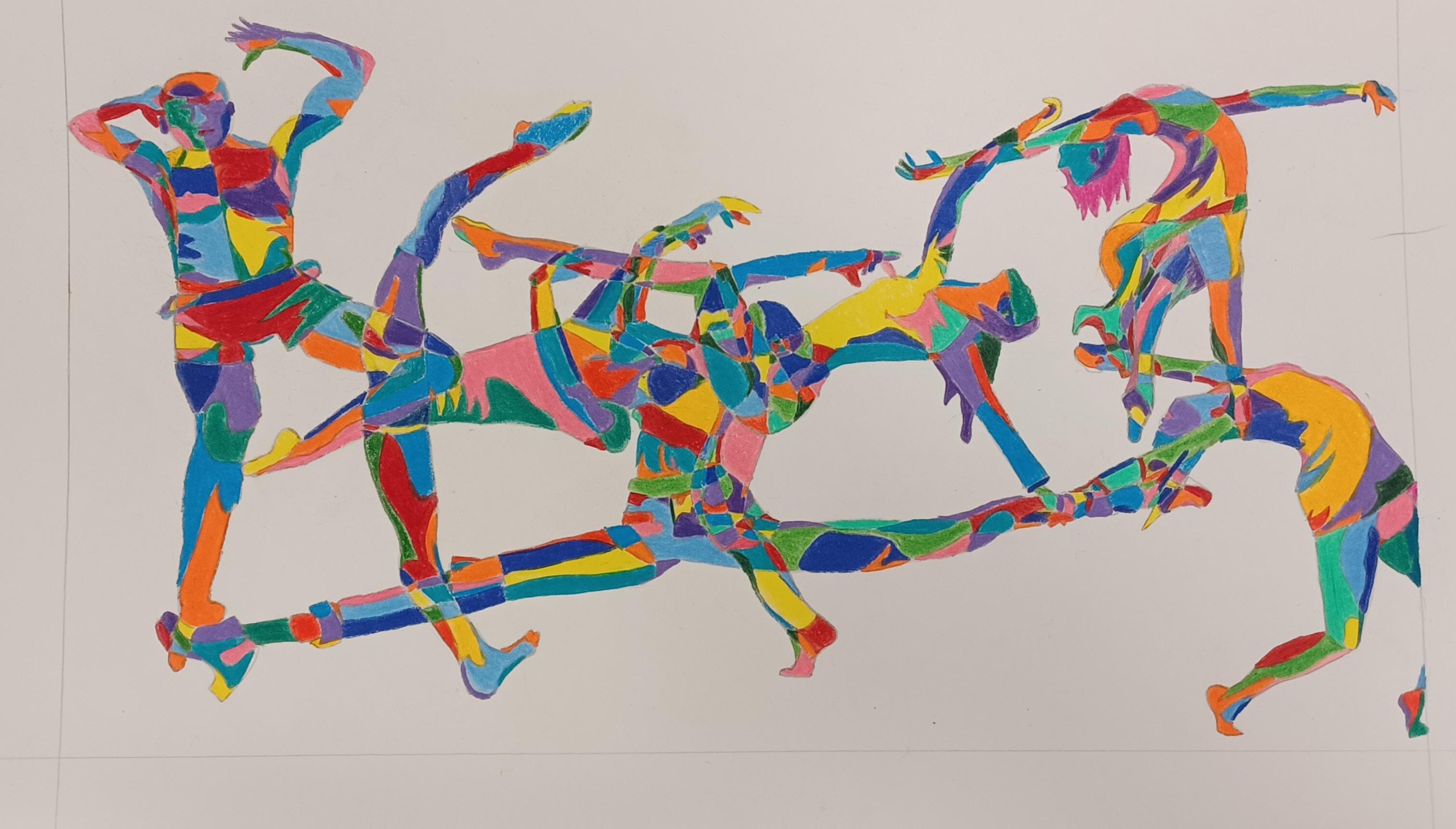
CREDITS

“We never taught him that,” is a common phrase I hear anytime someone asks my parents about the method I use to tie my shoes. Though I swear on my life that my parents indeed mentored my impeccable tying technique, they never have, and likely never will, own up to it. To any outside bystander fortunate enough to bear witness to my shoes being tied, my method of shoe tying could be summed up as “strange,” “bizarre,” or “weird.” From the length of my shoelaces to the knots they tie, I have never met or heard of anyone with my shoe-tying method.
It all started back at the ripe old age of seven. I was about halfway through my year as a first-grader when I found a new meaning in life — the gold stars awarded for good behavior. One particular day, for reasons now unknown, I was awarded three golden stars at school. As a chatty, nose-picking, and drool-wiping seven-yearold is wont to do, I was entranced by the illustrious gold coating of my newly earned gold stars. My hypnosis proved to be only temporary, as, in my fixation, I failed to realize that my street’s curb was fast approaching. As the three gold stars and the entire upper half of my body struck the ground, I, too, was struck with a profoundly shocking realization: my favorite pair of velcro shoes had ripped.
As much as I had hoped my three gold stars would distract them, my parents quickly detected the destruction upon my feet. Mom consoled me, then dad asked, “Do you want to get another pair of shoes?” Who was he kidding? Of course I wanted to get a new pair of shoes. As brilliant as my father was, I was astounded that he didn’t realize that half of someone’s first-grade popularity came from their shoes. With an excited
“goodbye” from my mom, my dad and I were on our way to pick out my newest shot at fame.
Upon reaching Marshalls (my No. 1 trusted footwear provider), I was confused when my dad led me to the “big boy” shoe aisle. Tempted as I was by the shoes with laces, I still knew my limits. I had utterly no idea how to even begin tying my shoes. Painfully aware of this fact, my dad broke the silence: “I think today’s the day you learn how to tie your shoes.” At first, I was excited. After picking out shoes as red as a mid-July stroll through a strawberry patch, I got to work. As five minutes of practice turned into 20, my excitement ignited into fury. Eventually, my dad got too impatient to carry on and insisted we leave so I could practice at home. Before we purchased the shoes and left, though, my dad made me promise to learn to tie my shoes. If I didn’t, he warned, my brand-new shoes would be returned.
No matter the different methods I was shown, I was incapable of independent shoe-tying. All seemed lost until I was made aware of “bunny ears.” One loop, then the other. Left goes under the right, pull them tight, and voilà, I had a bowtie(ish) knot on my shoe. I had done it, but my parents didn’t think so. They had never seen a knot like the one I had tied that night.
Since my first knot, I’ve come across challenges far more complex than those I had encountered in first grade — national-level business competitions, founding and running a club, and even mental health issues. But no matter how many knots I find myself in or loops I’m thrown for; I’ve learned to keep my head up, my bunny ears open, and carry on. I’ve learned to focus on what’s important, work until my goals are complete, and tie up any problems that arise in my own unique way.
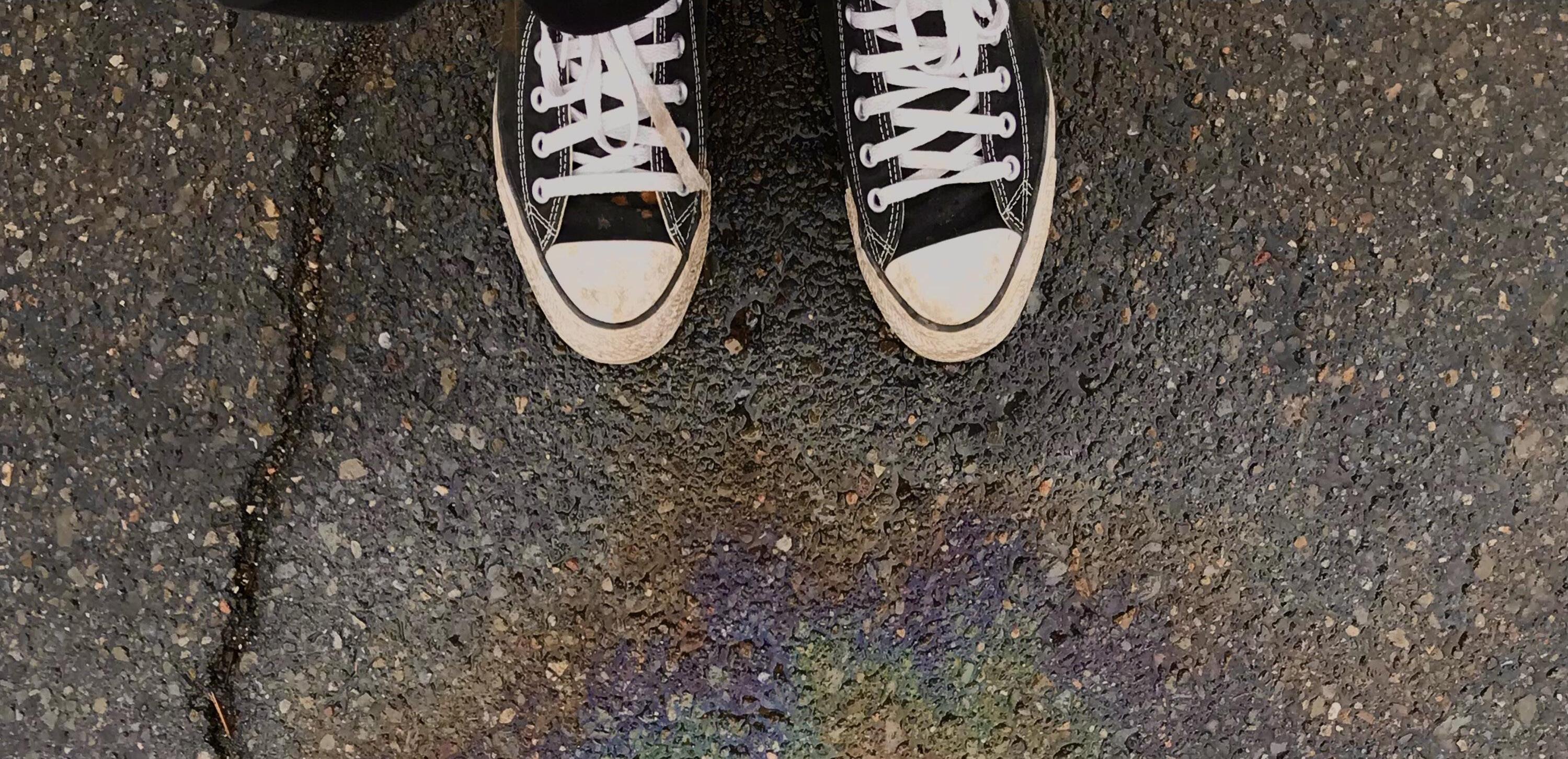
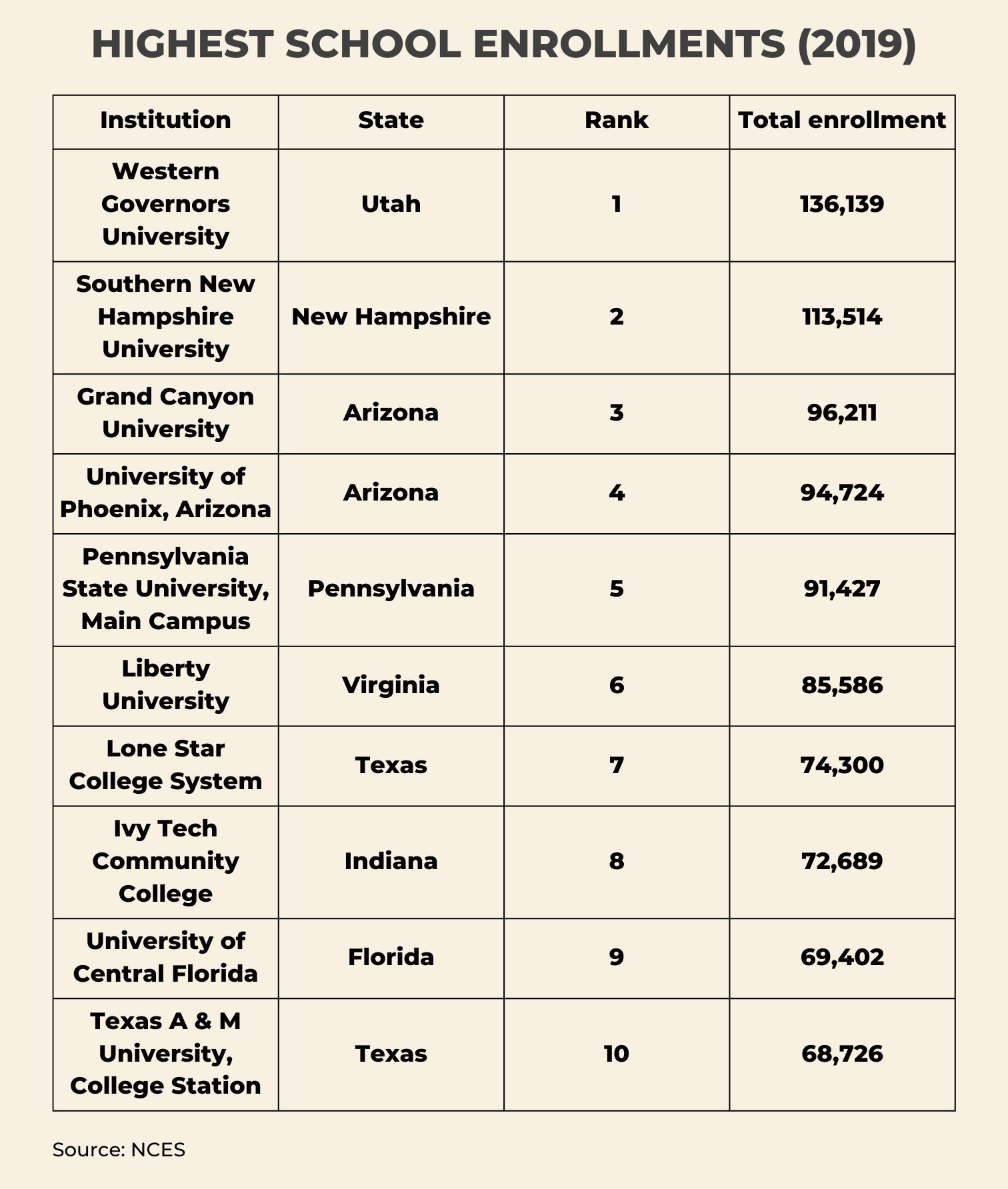

 ARTICLE BY ETHAN PARK, SAN JOSE, CA
TOP
ARTICLE BY ETHAN PARK, SAN JOSE, CA
TOP
College is a coveted opportunity for most, seen as one of the best ways to culminate an education and reach greater heights in order to secure a safe and happy living. But, of course, there are some that stand out from the rest. From the UCs on the West Coast to the Ivy League on the East Coast, there are outstanding colleges that have earned a reputation for raising the best and brightest minds, who will determine the future of mankind. Thousands apply, yet thousands each year are rejected, waitlisted, or deferred, being deemed unworthy as students of such universities. So what’s the secret to getting into such prestigious schools?
Despite claims that it isn’t as important as it seems, one of the defining factors toward college acceptance is GPA, or Grade Point Average. This is a statistic that takes a student’s letter grades and converts it to a 1-5 (or 1-4) scale. Of course, a 4.0 or 5.0 is the best score a student can get, but for those who fell in expectations, getting accepted into a strong college isn’t impossible. Indeed, while a terrible GPA can definitely cripple your expectations for college admissions, that’s not to say a mediocre to almost-good GPA isn’t recoverable. Other factors include your own personal situation, and how hard you work. For example, if you did rather badly in your early semesters of high school, you can still work furiously to catch up and do well in your later years. Another thing you can do is invest in extracurriculars and activities outside of school that can give you an edge in the competition. For example, let’s
say there are two people with a perfect GPA. However, one has won a national award in violin playing and has been playing for 11 years. Obviously, the one with the extracurriculars and awards would have a higher chance of getting in. These sorts of extra things can help boost your chances for acceptance as well. Another extracurricular that can help you get accepted is sports. Colleges often place high value on talented athletes, and reward them with scholarships and acceptances to join their college teams. These athletes will then go out and compete on a college level against other schools in Divisions 3, 2, or even 1.
Of course, you might ask, “Well, I already won’t have a 4.0 or good activities, what’s the point in doing well later?”
Well, one unspoken thing that college admissions officers often enjoy is a story. Think about it:
There are millions of people in the world who have gotten perfect grades. What sets people apart are their stories and motivations for such things. Colleges don’t want someone whose goal is school, they want people who aim for the future. Even if you didn’t do so well early on, the story that is painted by your hard work is “this is a student who fell short, but realized their mistakes in order to reach their full potential,” instead of “this is a student whose capacity is limited to low effort and low grades.” And even if you didn’t start out doing sports or music, a late start is better than nothing. There have been people who have inadvertently discovered their hidden talents while trying new things out in high school. As the saying goes, “You miss every shot you never take.” Giving up should never be a response, no matter how under accomplished you may feel you are.
The last thing that should be considered is the act of choosing a major. Often, certain majors are extremely popular among students, giving way to high competition in those sectors. These majors include Biology, Biochemistry, Computer Science, and Psychology. The students applying for these majors are probably on the same level or even better than you. This is not to discourage applying for these majors, but to enlighten you that
there are other options available. One way to get into a school with your passion is to consider doing more than one major. This way, you show the college that your talents and passions lie not only in one subject but others as well. Of course, in the chance that you

to spare (or block off such moves entirely), but it should be possible in many cases.
All in all, while college is one of the most important experiences of one’s life, one should not despair if they had a late start or lack some things their peers have. Indeed,
do get accepted, college life will be harder, since doing two majors is obviously more difficult than doing one. However, the reward of acceptance into a possibly prestigious school probably makes the hard work worth it in the end. Another tactic students may try is either entering with an uncommon major and switching to their interests later. Since the STEM sectors have high appliance rates, one might consider applying to the liberal arts or language sectors in order to get accepted, take one year of that major, and then switch to the subjects that they are actually interested in. Of course, this does not always work, since the more popular majors often have no room
while the admissions officer might just see numbers and letters on a page, those numbers tell a story of nobody else but you. Each and every person is unique, and playing on your own strengths is what makes you stand out to get accepted. Of course, this is not to say hard work is not needed or GPA is irrelevant; in fact, these are two extremely important factors in college admissions. This is just to say that there is still hope left for anyone who lagged behind or chose not to work hard early on. From east to west, I truly hope that each and every one of you young readers fly far and above your expectations and reach the sky in the future.
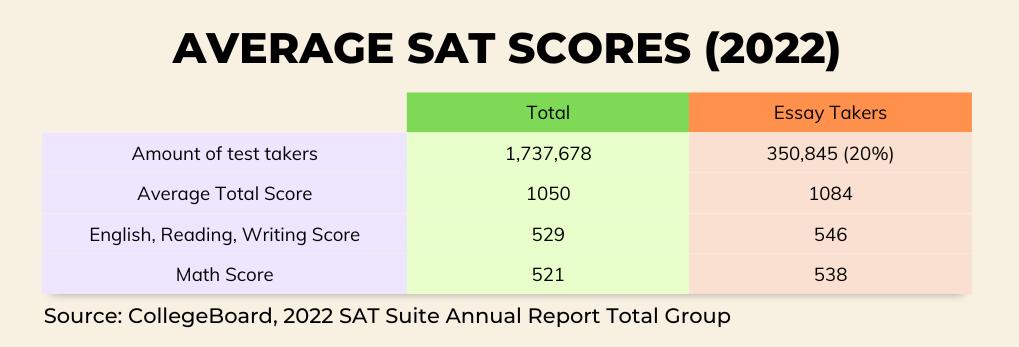
COLLEGES DON’T WANT SOMEONE WHOSE GOAL IS SCHOOL, THEY WANT PEOPLE WHO AIM FOR THE FUTURE
Access to an adequate education is one of the most basic rights possessed by humans. Without it, people lack the enlightenment and inspiration that has led to everything from immense technological advancements to simple interactions. Despite the incredible importance of a strong education, there is still poor access to schooling for a large part of the population. In the United States, that proportion is unfairly skewed in the direction of minorities. Most minority groups have faced centuries of scorn and abuse, and education has been no exception. Now more than ever, all people should be provided equal chances to obtain an education, which is why affirmative action should be allowed as one aspect of the college admission process. When used responsibly and in conjunction with other criteria, affirmative action can be used to diversify the student body of a college while not infringing on the constitutional rights of citizens.
The addition of racial diversity in a student body can be an invaluable asset to a school. With diversity, new perspectives and knowledge flows into the classroom. For some schools though, obtaining diversity can be a difficult task. Factors such as lack of access to educational facilities and underrepresentation can hold back prospective minority students, thus leading to an unvaried group of applicants. To remedy this issue,

some institutions employ the use of affirmative action in their admissions process. Affirmative action can be extremely beneficial when used with proper restraint.
In 1978, the Supreme Court allowed the University of California to continue to consider race in admissions decisions, but said racial quotas went too far. Then, in 1995, their affirmative action policy was removed, and a drastic decline in diversity ensued. Edward Lempinen at UC Berkeley shows how this change adversely affected minority students when it was enacted three years later. “The measure deterred more than 1,000 underrepresented minority students per year from applying to any UC campus…”
A decline of this magnitude was disastrous for trying to maintain a diverse student body and its intrinsic benefits. This example highlights how an affirmative action policy can be beneficial because before the revocation, the University of California system had students from many backgrounds. After the change,
With diversity, new perspectives and knowledge flows into the classroom
the number of students who fostered diversity declined and left the university with less minority representation. The loss of so many students from different backgrounds undoubtedly, and unfortunately, reduced the variety of viewpoints in many classrooms. As the example shows, using affirmative action can be a positive decision unless it is exploited through the implementation of factors like exact quotas.
When schools use affirmative action improperly, such as a quota system, it can lead to the very conflict that is trying to be solved. Some schools have implemented a strict quota in their admissions review, but a quota is not an adequate solution. By using quotas, the school is inadvertently shunning and discriminating against some applicants from majority groups. The very issue of exact quotas was addressed and disapproved in a Supreme Court case many years ago. “... Regents of the University of California v. Bakke, ruling in which, on June 28, 1978, the U.S. Supreme Court declared affirmative action constitutional but invalidated the use of racial quotas…”.[2] The decision mentioned in the Bakke case underscores that the use of quotas is not an ethical decision. It would incidentally cause further discrimination and a never-ending cycle of biased decisions. Even though affirmative action raises concerns about potential misuse, the Supreme Court has shown that the program passes strict scrutiny and is therefore necessary.
The Supreme Court is often faced with divisive decisions that must be carefully analyzed; affirmative action has been in numerous cases that fit that description. In order to deal with such tremendous decisions, the Court uses the strict scrutiny standard. The strict scrutiny standard involves rigorous assessment of a proposed law or rule to determine if it is truly necessary for improving the lives of
people. In the University of California case, the Supreme Court, with the use of strict scrutiny, ascertained that a balanced affirmative action plan was constitutional. The justices stated that there was no violation of the 14th Amendment or Civil Rights Act because minority status was not the only factor being used to admit students. The program also passed strict scrutiny because it was benefiting minority groups that were underrepresented, and there was not another viable way to do so, according to the court case. Based on multiple Supreme Court decisions allotting for racial criteria in admissions, it is evident that affirmative action is constitutionally sound. Including minority status in admission decisions does not go against the law, meaning schools can continue to use those criteria. Having programs like affirmative action increases the welfare of many citizens in ways that other programs cannot, which is why they should remain in place.
Because education can be improved by adding diversity to a student body, a well-rounded affirmative action plan should be used in admission decisions. There have always been certain minority groups that face difficulty when trying to attain a higher education, so they should receive equal representation and better chances to attend post-secondary school. While affirmative action does accomplish this task, it can be abused when schools go too far and require exact quotas for some minorities. Despite the problems posed by quotas, there is compelling evidence that affirmative action can be effective when used properly. By using affirmative action, educational facilities can create a diverse group of students with a variety of views and knowledge. The next world-changing invention, event, book, or anything else could come from a person of any background, so everyone needs to have equal access to a higher education that helps them reach their goals.
BECAUSE EDUCATION CAN BE IMPROVED BY ADDING DIVERSITY TO A STUDENT BODY, A WELL-ROUNDED AFFIRMATIVE ACTION PLAN SHOULD BE USED IN ADMISSION DECISIONS


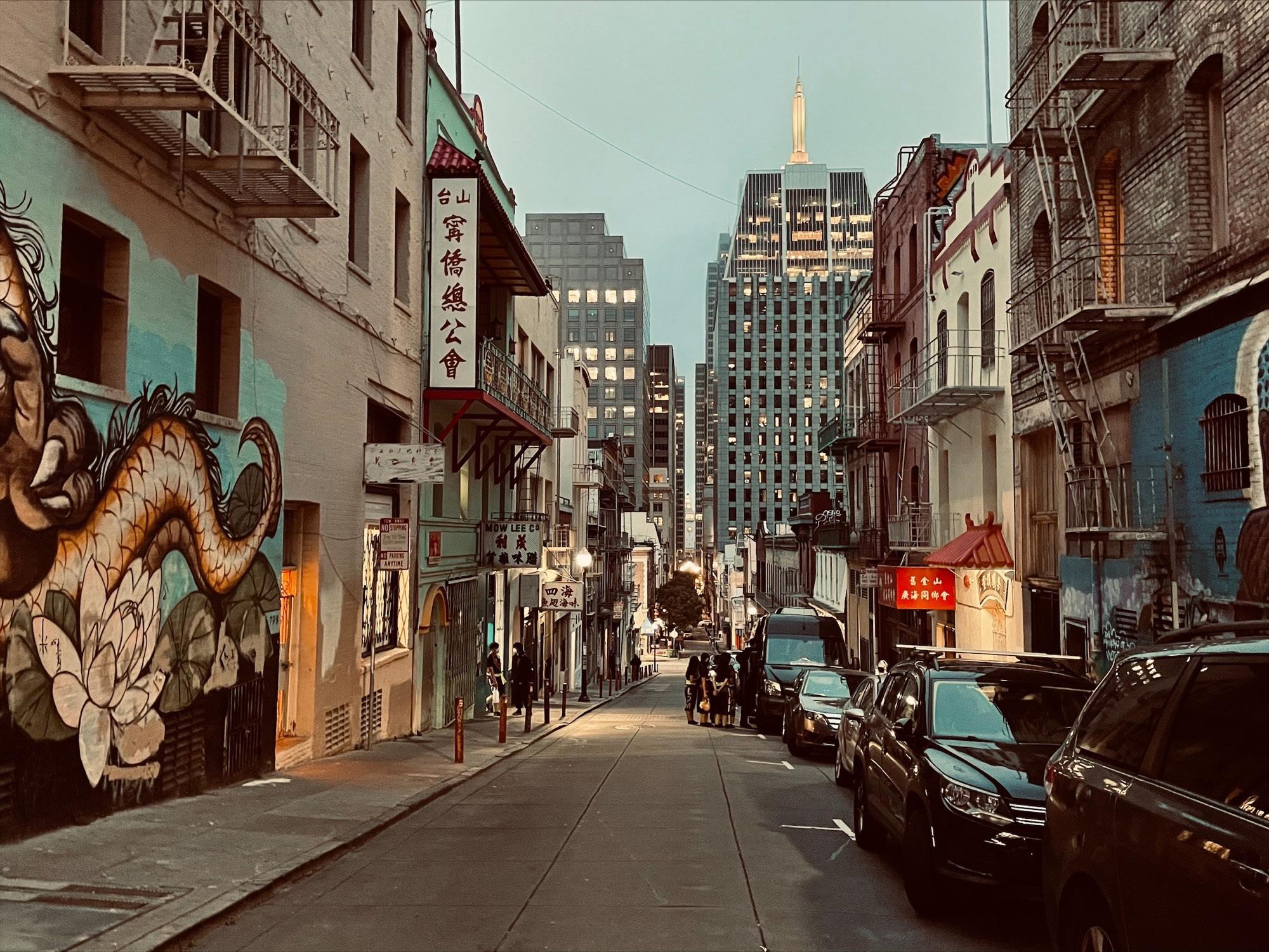


 PHOTO BY ALLISON LIU, LEXINGTON, MA ��NAMIB DESERT, AFRICA
PHOTO BY EVA LEPENDORF, PRINCETON, NJ ��LAKE LOUISE, AB, CANADA
PHOTO BY ALLISON LIU, LEXINGTON, MA ��NAMIB DESERT, AFRICA
PHOTO BY EVA LEPENDORF, PRINCETON, NJ ��LAKE LOUISE, AB, CANADA







LOPINION:

Education is essential to society as we know it. It is what propels our civilization toward the future and grants people the skills they need to contribute to the world through their careers. If education is so important, then why is it so unaffordable to most Americans?
According to Student Loan Hero, Americans owe nearly $1.75 trillion in student loan debt, spread out among about 46 million borrowers. Over $1 trillion is an amount that I can not even fathom, and it is growing exponentially everyday. The trend that surrounds this startling statistic can be stopped, though. It would be beneficial to American society to make college free and put an end to the student debt crisis.
One of the largest benefits that would come from free college is more enrollment. The reason that many people who want to go to college, but choose not to do so, is because they fear paying a high tuition. This prevents so many qualified individuals from getting a higher education and pursuing the career that they want. In an interview with The Balance,
Morley Winograd, president of the Campaign for Free College Tuition, said free college programs are successful in persuading students who felt as if they would not have been able to afford continuing their education otherwise. The initiative of free college would help the underprivileged people in our country achieve success and prosperity. Since more people would be able to get the education and jobs they desire, American society will improve.
One aspect of our society that will be greatly affected is the economy. Free college will cause our nation’s economy to improve by leaps and bounds. Since the cost of living is already so expensive without student debt, leaving college with tens of thousands of dollars in loans makes the financial lives of graduates incredibly difficult. They are reluctant to participate in the economy because their student loans are hanging above their heads, always reminding them that they are not free from the financial burden of college tuition. This would not be the case if college was free.
In a Best-Universities.net article on the merits of free college, the writer says, “Yet, if people were to graduate without debt, they would immediately be able to begin earning, saving, and spending, thus stimulating the economy… there becomes a need for more workers, creating more jobs.” Because the economy will vastly improve with free college, the extra taxes that will need to be paid for free college will pay themselves off with the increased economic activity. This is a situation that will benefit everyone in America for years to come.
Free college is a policy that could only offer positive outcomes for American society. Several countries in Europe already have free college and are reaping the benefits. Once America decides to join these European countries, the improvements will change the nation for the better. In a society with more educated people pursuing the careers they want and a better economy, America would only have one way to go — up.
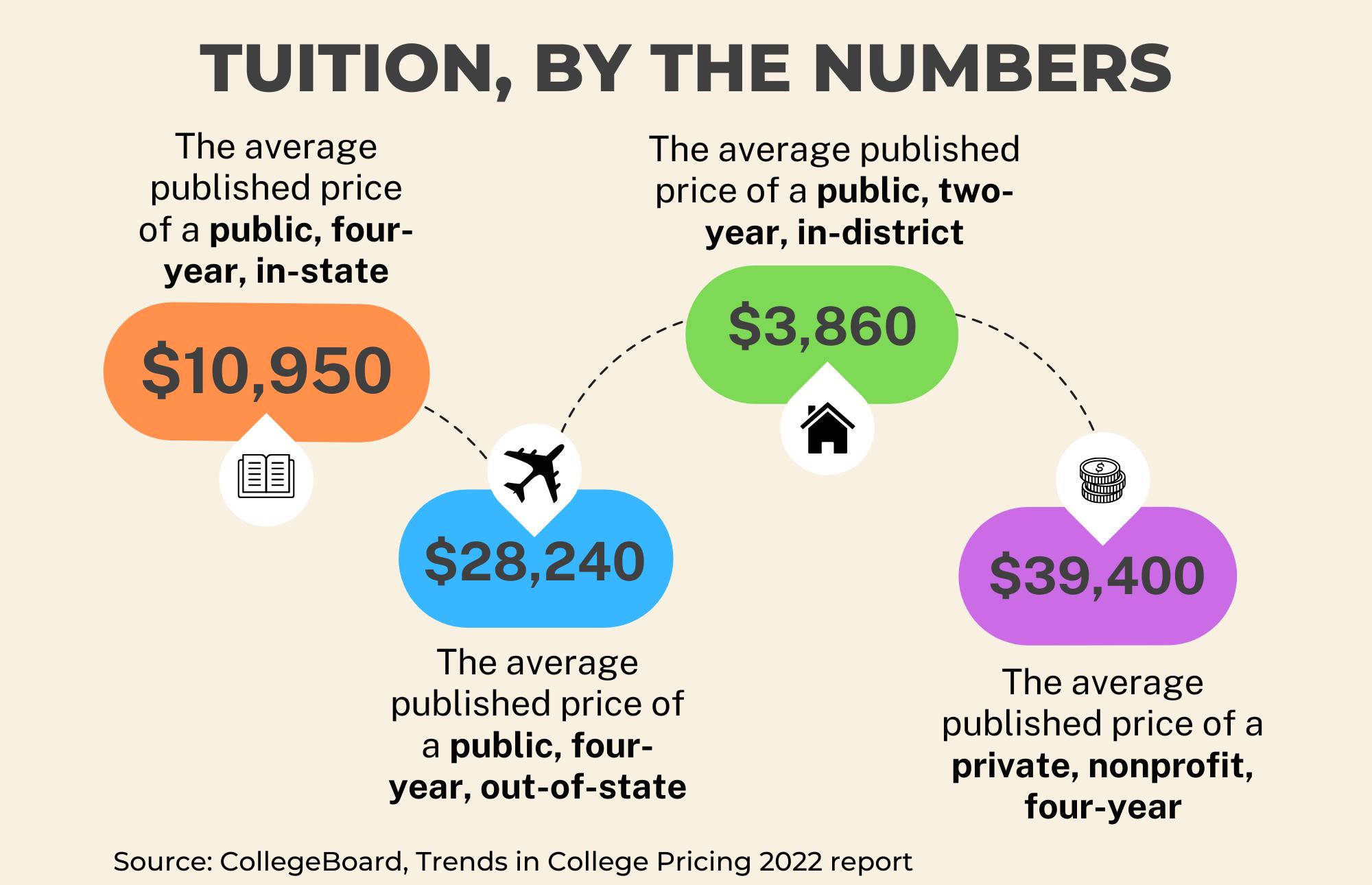


As soon as I entered the seventh grade, the idea of planning for college and excelling in academics and extracurriculars was constantly impressed upon me. Viewing college banners draped in every hallway as soon as I stepped into my new middle school building, and even sitting down in my first period class, where my teacher warned that “grades now matter,” frightened me senseless. I have definitely thought about college since then and had a few schools in mind, but the stress would not hit hard until I reached my junior year of high school.
I joined a program called “Imagine College” through my high school, where the mentors would emphasize applying to our dream universities, even if they were incredibly expensive. They convinced us that money should be no barrier, but the reality could not be harsher.
My dream school has always been the University of Connecticut, and when I got accepted, I thought, “Wow, not only would I be experiencing the Husky Life I dreamed of, but

with even more than I borrowed. I worry that in my future I will be drowning in debt, while also being preoccupied with paying for daily life expenses. Northeast Valley News shared a personal experience from an aspiring college student, saying “neither of his parents were able to go to college, and in hopes of ending that cycle, he ended up taking two jobs and joining the ROTC to try and graduate with as little debt as possible. He described many nights where he would think it was impossible and experienced anxiety attacks and a lack of confidence in his ability.”
Similar to this student’s reflection, the majority of college or aspiring college students are trying so hard to balance their impossible schedules just to make ends meet. However, college is supposed to be an exciting experience with new opportunities, adventures, and knowledge, in an environment where students actually savor them. Constantly stressing and working ridiculous amounts of hours is detrimental to the college experience. By the time students graduate, their overflowing debt will be a souvenir of the stress and exhaustion they experienced throughout their college journey.
also UConn would make it affordable enough for me because I am in-state, demonstrate much financial need, and show promising results in academics.”
When I was hit with the university’s financial aid offer, I was heartbroken and overwhelmingly stressed. It became clear to me that I would have to apply for an insane amount of scholarships and start searching for summer jobs to pay a fraction of what the university is expecting of me. Filling out paperwork for scholarships every day and searching for summer jobs has been so stressful, especially with the painful truth that I will also have to take out bank loans.
I come from a low-income family and dread thinking about the idea of taking out loans for university and having to repay the bank
This can change. If college is free for those who are unable to afford it, they would receive the same opportunity as everyone else. Rhode Island has implemented a scholarship program that provides students with the opportunity to get an Associate’s degree (two years) for free at the state community college. According to EdSource, the state “saw its community college graduation rate triple and students of colors’ graduation rate increased ninefold.” How they will utilize that chance is up to them. What matters is the self-confidence they feel entering college in order to work for their degree without constantly beating themselves up and living in a life chained down by debt. Everyone deserves a chance to better their lives and be proud of their accomplishments. College’s main objective should be to ensure everyone wanting to attend can create a significant and positive impact on their lives and the lives of their hopeful family members as well.
I worry that in my future I will be drowning in debt, while also being preoccupied with paying for daily life expenses

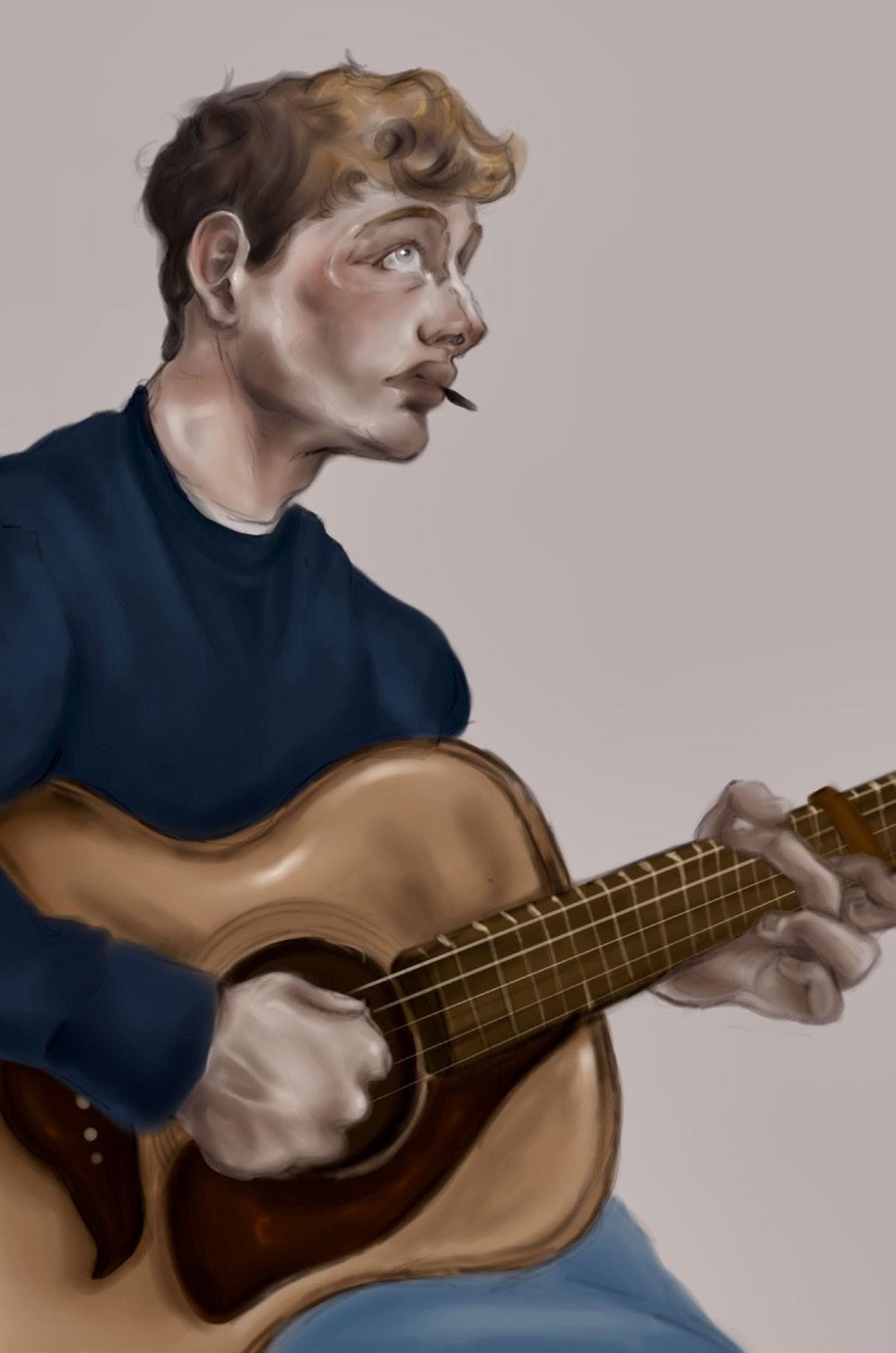

Education is a necessary part of life. The ability to read, write, and solve basic math problems is often taken for granted. Although I never plan on using the quadratic formula or analyzing a Shakespearean tragedy ever again, that doesn’t invalidate the wonderful people who work tirelessly to teach me. It doesn’t change the fact that I have school to thank for at least a portion of my common sense, and my ability to think semi-critically.
I tell people that I am taking a gap year, but I dread explaining my plans to them because I know how it sounds. It sounds like I’m lazy, or stupid, but my decision makes me more self-aware than many people my age.
I’m not wasting money; I am giving myself the time and space to cultivate it. I’m not wasting time; I am allotting myself valuable life experiences. I am being smart, because I know that a future of textbooks will not increase my knowledge base. I know that a dorm room would not improve my
well-being. And I know that “academic” assignments would only fill my freetime with stress,
FINDING YOURSELF ARTWORK BY ANONYMOUS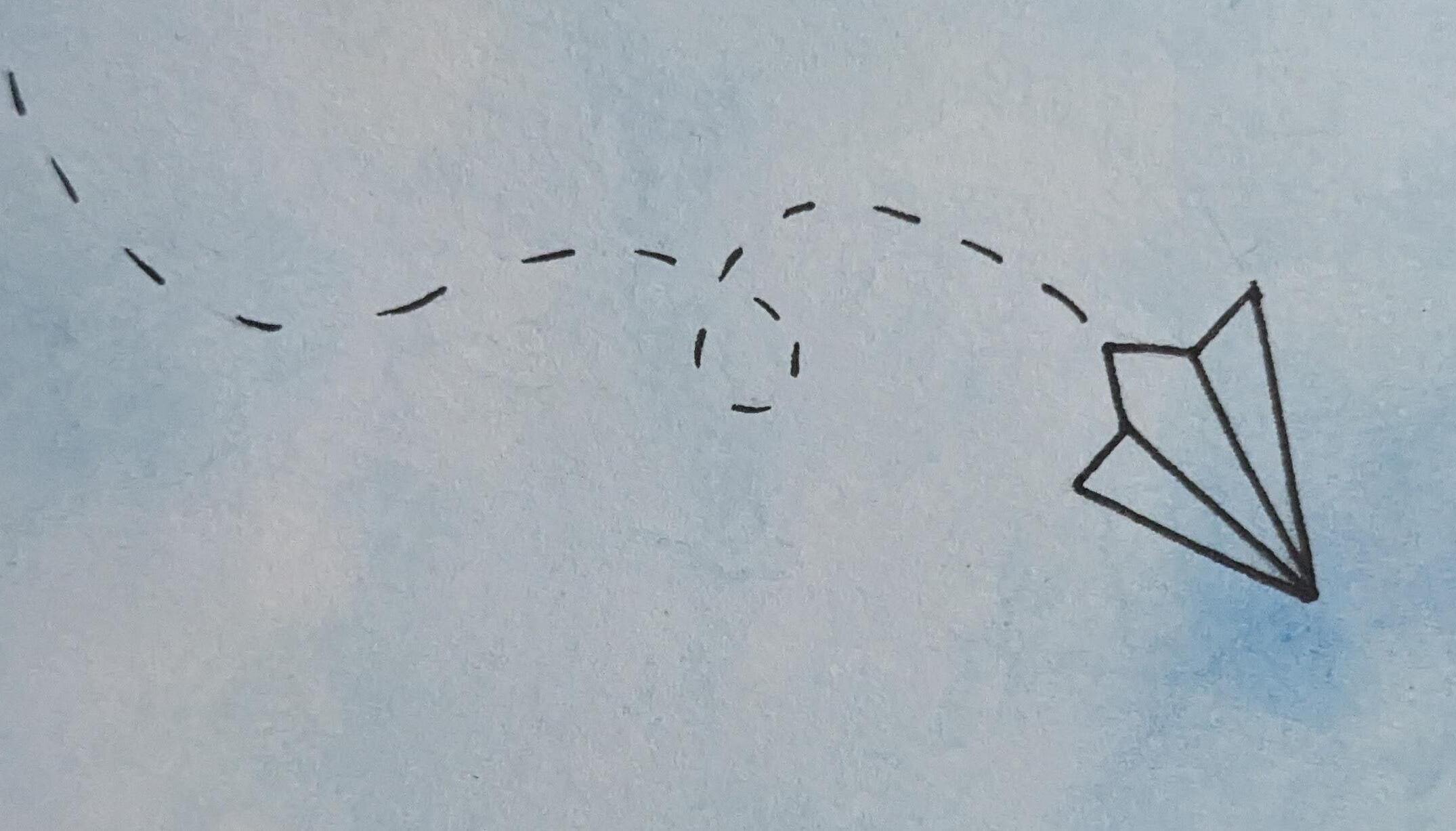
and would lead me to develop bad habits.
Life is going to lead people down an infinite number of different paths, meaning that everybody’s daily responsibilities simply cannot be accounted for. This makes quantifying the amount of work that students have to complete an anecdotal task. Memorizing lines for drama club, dribbling basketballs through the gym at practice six days a week, or flipping burgers at their part-time job doesn’t tell a
ARTICLE BY RAVEN MORGAN, MELBOURNE, FLstudent’s whole story. It’s the little things that often go unnoticed that end up snowballing into a burned out student body.
At some point, it is no longer helpful to pressure me into cramming random, filtered facts into my head for one night, to test how accurately I can regurgitate those things the next morning.
To be intelligent is not to simply be compliant. Anyone who wants to can study a list of elements in a chemistry class, but to have to prove someone’s ability to do so is ineffective and often does not align with actual ability. This should not be the determinant of what someone is capable of. Unfortunately, some people have their sense of self-worth so entangled with this external factor that they cannot differentiate between their own desires and those of others. There are so many beautiful things to experience in life, and the last thing I want to do is make myself busy with paperwork and deadlines.
I TELL PEOPLE THAT I AM TAKING A GAP YEAR, BUT I DREAD EXPLAINING MY PLANS TO THEM
 ARTICLE BY ANONYMOUS
ARTICLE BY ANONYMOUS
One bitterly cold night, I wander along the roads in my mountain town. I trudge through the snowy grounds as the wind slaps my soft face, coloring my cheeks a bright pink. My shadow gives the impression that I am a giant fluffy marshmallow due to being bundled up in my puffy winter jacket.
As I gaze above into the crystal clear sky, the stars twinkle while dancing in my sight. The streets stay dimly lit by the old-fashioned city lamp posts. When entering the friendly neighborhood park at the end of the road, I feel myself slowly becoming enclosed by the crawling darkness.
Perched on a hill overlooking the city, I caught a rustic wooden
The pressure lies solely on me to choose wisely and quickly. College is right around the corner, and everyone awaits my decision on a major.
The fear of choosing the wrong major consumes me, ripping apart my insides. A poor decision could lead me to a life of utter darkness and despair. The last thing I want is to end up as a 40-year-old, regretting my life choices, and wishing I could go back to college to pick a different career. Is it possible to live a life with no regrets?
I feel lost while resting peacefully on the bench, enjoying the night sky. I feel as if the sky will somehow speak to me and tell me

As I observe my surroundings, I hear the tree branches clash in the hallowing winds. The snow shimmers from the light of the stars. The animals whisper back and forth — the lights in the sky act as their guide.
Where is my guide?
bench in the corner of my eye. Sparkling white snow dusts the seat. It lies partly hidden in the shadow of the sprawling oak tree. After approaching, I scrape off a portion of snow with my nonwaterproof gloves — I didn’t think that one through.
Relaxing on the bench, I admire what the lights offer. Each star is like a possible major; all majors lead to an infinite number of unique careers. Any of these careers can lead to a life full of light. As my thoughts spiral, all the stars seem to shine at the same magnitude.
I lose sight of the north star that is supposed to guide me down my path. The daunting possibilities that fill the sky overwhelm me. There are too many choices. I need clarification on which one to follow. My growing curiosity wants me to explore everyone — unfortunately, that isn’t an option.
which major is the right choice — maybe I watched too many Disney movies growing up — so I continue to sit and ponder. My head fills with my mother’s words, “The possibilities are endless, honey.”
How can there be so many possibilities? I won’t get to see what most of them are.
I always thought college was a place to learn and explore who you are and discover what you would like to do for the rest of your life. Never in a million years did I think I was supposed to have my North Star predetermined. The thought bewilders me.
How can I even explore my passions when I don’t know what they are? Are my current goals and dreams even worth pursuing? I’m only 18. I’m too young to decide what I should do for the rest of my life.
Frustrated, I try to understand the education system, hoping it will help me. I think about the philosophy of kids choosing a major before arriving at college. Students with similar interests in majors can be housed together to develop stronger friendships and can encourage good study habits. However, the chances are slim that someone will stick with the major they first picked. Many blindly choose without actually knowing. The grouping of similar individuals robs me of the opportunity to learn about other majors from different people. I cannot genuinely grow because I am stuck in an environment where everyone’s vision is the same. I mumble to myself, “Why can’t I decide?”
The bench feeds my brain with ideas and curiosity. My indecisiveness makes me wonder what major can lead to almost any career. Which major will allow me time to explore the possibilities? And boom: Business pops into my head.
Does that sound alright? It will have to do for now.
So, I stand up from my bench and use the light from the North Star to find my way back home. As I meander the streets, I question my decision with every step and every breath. I pray I am not screwing up my life by selecting Business as my major in my future university’s student portal.
EACH STAR IS LIKE A POSSIBLE MAJOR; ALL MAJORS LEAD TO AN INFINITE NUMBER OF UNIQUE CAREERS
 ARTICLE BY ROBYN DAVIES, WEBSTER GROVE, MO
ARTICLE BY ROBYN DAVIES, WEBSTER GROVE, MO
In recent decades, habitat destruction, resource exploitation, carbon emissions, deforestation, and disturbances to natural equilibriums have left a detrimental impact on the balance of global ecosystems. With 2,000 new species endangered annually, we must take action now.
First, we must protect habitats. Preservation starts with calling upon national governments to conserve habitats within their regions by restoring deforested areas, reintegrating endangered species into new habitats, and restricting human interference within protected areas. Such conservatories must take equal care to conserve animal life within these protected areas, bearing in mind the detrimental impact of species extinction on the balance of global ecosystems. Our second action must be raising awareness, involving governmental bodies, international organizations, NGOs, and individuals alike. This entails not only developing a global climate curriculum in coordination with the UNEP to address topics such as region-specific environmental concerns and individual climate responsibility but also establishing government-mandatory labels defining the sustainability of manufactured goods in hopes of raising consumer awareness. Both programs’ accessibility in virtual and physical formats will be vital to their success. As time will certainly bring new challenges and innovations concerning environmental stability, an annual review by the UNEP will ensure its implementation remains equally relevant, accurate, and effective.
However, on our path to a more sustainable future, we must also consider the people currently dependent upon environmentally threatening work. With concern to farming populations, restorative ocean farming techniques particularly may prevent environmentally-taxing work while equally revitalizing marine ecosystems. Whether planting and harvesting aquatic plants, encouraging the farming of sustainable shellfish species, or financially supporting Regenerative Ocean Farming NGOs such as GreenWave’s polyculture ocean farming methods, restorative ocean farming solutions can nurture both an ecosystem for endangered coastal species to thrive and natural solutions to balance carbon emissions.
On the point of balancing carbon emissions, Carbon Engineering’s Direct Air Capture (DAC) solution must not be ignored. DAC plants directly sequester carbon from the atmosphere and condense it into recycled carbon pellets. Under independent organizations, this carbon can be used as a recycled energy source, approaching net-zero emissions. Under government funding, this extracted carbon could be removed from our atmosphere permanently.
Though the climate crisis remains a crisis unsolved, one thing is certain: scientists have the technology. It is now our responsibility, as students, activists, and future world leaders, to implement these technologies as the environmental solutions that revitalize our Earth.
If given the opportunity to have unlimited resources, power, and money to save the planet, the first step would be to invest heavily in renewable energy. We need to build more solar farms, wind turbines, and hydroelectric plants to replace our reliance on fossil fuels. This will help reduce greenhouse gas emissions and create job opportunities, spurring economic growth.
Another area that needs our attention is sustainable agriculture practices. By promoting organic farming, agroforestry, and regenerative agriculture methods, we can reduce the use of synthetic fertilizers, pesticides, and herbicides. We can collaborate with farmers to adopt practices that preserve soil health and biodiversity, reduce water use, and mitigate the impact of climate change on crops.
Sustainable transportation is also crucial in the fight to save the planet. We need to invest in public transportation systems like high-speed rail, buses, and bike lanes to decrease the number of cars on the road. Additionally, we can offer incentives like tax credits, subsidies, and free charging stations to encourage people to use electric vehicles.
Proper waste management is another critical area we need to focus on. We should promote the use of recycling, composting, and waste-to-energy technologies to decrease the amount of waste that ends up in landfills. We should also work with governments and businesses to decrease packaging waste and encourage the use of sustainable materials.
Finally, education is key in the fight against climate change. We need to partner with schools, universities, and community organizations to provide resources and training on environmental issues and solutions. We can work with the media to promote positive stories and examples of sustainable practices and innovations. By doing so, we can inspire people to take action and create a sustainable future.
In conclusion, if we are given the power, money, and resources to save the planet, we need to focus on renewable energy, sustainable agriculture, sustainable transportation, sustainable waste management, and education. By taking action in these areas, we can create a better future for ourselves and for future generations. Let’s work together to make every day Earth Day!
ARTICLE BY EDWARD JAEWON KIM, MARION, MA
In 2016, when the Paris Agreement was signed by most countries throughout the world, there was great hope that global collaboration would tackle the global warming crisis. Unfortunately, however, it is presently clear that a significant number of those countries are failing to put into action what they wrote on paper. While money and resources are useful, it would seem that ultimate power is the key to making Earth a sustainable environment. If countries aren’t willing to confront the issue that the world is facing, it doesn’t matter how much money and technology exists. To the contrary, ultimate power would force leaders throughout the world to abide by steps that are a necessity to the future of the human race. For instance, a universal carbon tax law would ensure that each country could only burn a certain amount of fossil fuels each year. This would result in a conspicuous decrease in the amount of greenhouse gasses released into the atmosphere, which would cool the Earth as well as decrease the number of deaths caused by local air pollution issues. Collectively, the nation would benefit at the same time as the rest of the world.
Similarly, banning private vehicle ownership and only
operating public transportation in big cities would be another critical step one could take if they had unlimited power. Urban centers with a population above 25,000 could be forced to create public network systems that remove the need for citizens to use private vehicles. Such a policy would help reduce carbon emissions and provide convenience to citizens who could still move from place-to-place without facing the financial burden of owning vehicles, such as cars and motorbikes.
The pattern that emerges is that these decisions benefit the people of the world on both a local and international level. Currently, there is a significant amount of division between a great number of countries throughout the world, which makes it impossible to take the essential steps required to avoid climate catastrophe. Thus, the issue is not about money and technology since we already have an abundance of those two factors. Instead, it is about somebody, or an institution, having the ultimate power to implement international collective change without resistance. With power comes the ability to create true change for the greater good of society.
 ARTICLE BY CASSIDY WATSON, ST. JOSEPH, MI
ARTICLE BY CASSIDY WATSON, ST. JOSEPH, MI
Long days led to restless nights until that dreaded day. I thought graduation was hard, but this was going to be worse. My best friend, my sister, was leaving for college. I tried to make myself feel bad for being utterly miserable about this — other people had it worse; their siblings are moving halfway across the country. I didn’t deserve to feel bad. My head was swirling with a thousand thoughts I couldn’t control. Thinking — my worst enemy that constantly attacks me until I fall down an endless hole.
Alas, the day arrived. My family woke early to pack the car and drive to the college. I sat in the backseat with my headphones on while reading a book. I was trying to block out the negative thoughts, but it didn’t work. My sister was trying to act positive the whole ride for my sake. She knew I wasn’t handling this well, but who could blame me? There would be no more late-night talks about our day, no more driving around shopping and blaring music in the car, and no more running into each other in the hallways late at night when one of us went to the bathroom or got a midnight snack.
From that moment on, that was all over. I didn’t want to face that reality, so I slid my thumb down the side of my phone, instinctively stopping when I reached the volume button. I pressed it until my phone yelled at me to stop — it finally reached full volume. When we arrived, all I wanted to do was sit in the car in silence until the day was over. And I did do that, at least for a few seconds, until my dad, full of energy, said, “Let’s go; we’ve got a car to unload.”
Emily, her boyfriend Tim, and I decided to take her things to her room while my parents waited for my other sister to arrive. When I walked through the hallways, musty and poorly lit, the back of my neck became damp and cold. At this point, I expected to see the twins from “The Shining” at the end of the hall. Somehow, it was even worse when I saw her dorm room. The floors were dusty, and the walls were gray and cold, the one on my sister’s side being concrete and unwelcoming. Bile rose in my throat at the thought of her living here. It looked like a prison cell. How could she live here? I can’t just leave her here; she’ll be miserable. While Emily started unpacking her things, I started talking to Tim.
My mom and I got out of the car and started placing the laundry baskets full of her things on the sidewalk. The sun blinded me as I stepped out of the truck; thankfully, it was a gloomy day. However, my eyes were still sensitive from the previous nights spent drying the many tears that flowed down my face.
“I don’t know how she’s going to live here. It looks like a prison cell.”
“I know,” he replied. I felt bad for him. He wasn’t handling this well, and neither was I, but I had never seen him like this except for the week leading up to her departure. Exhaustion hit as we had barely started to set up her room. I didn’t want to help, I just wanted to sit there in my misery. I was in a fog so,
I THOUGHT GRADUATION WAS HARD, BUT THIS WAS GOING TO BE WORSE. MY BEST FRIEND, MY SISTER, WAS LEAVING FOR COLLEGE
mindlessly, I did what everyone told me to.
“Give this to your sister.”
My arms passed through the air with the clothes in hand.
“Put my keys over there.”
The keys clinked as I set them on the tote, a pathetic sound. Everything was upsetting me, even if it didn’t have anything to do with her leaving. Everything else that happened when we set up her dorm was a blur. The walls were suffocating me, and I was drowning in the lake of noise that filled the room. Tears were beginning to form, but I didn’t want to cry.
“Is everyone ready to go?”
That was fast.
The immense amount of pain that pierced the air on the car ride to the store was enough to make me want to jump out of the truck. I walked around the store trying to distract myself. “We need batteries.”
“Oh look, this lady needs help.”
“Wow, keyboards and technology.”
I wandered off with Tim and occasionally looked around to see if there was something to talk or make a joke about. Nothing. The sadness that possessed our bodies was too much.
Driving back to the school was much more pleasant, considering everything that had been going on. Emily had just gotten a polaroid camera, and we decided to take pictures. The camera clicked with a bright flash as I tried not to cry while I captured the moment of Emily and Tim hugging. I want this day to be over, but I don’t want to leave.
My parents decided that since the room was set up, they would part
ways. Sitting in the corner, I tried not to look while they were saying their goodbyes. I didn’t want to cry. I hate crying in front of people, especially my parents. My eyes were turned to the ground, not knowing what to do at the moment.
Finally, they left. The room was quiet. The only light source came from the suicide-proof window. It wouldn’t even be that difficult to squeeze a tiny, malleable body through if someone really tried. It’s not like it would matter anyway because the dorm was on the ground floor. Emily’s voice snapped me out of my thoughts.
“I have to leave to go to an orientation thing at 6:30. When I get back, we all can go do something.”
“Okay, we’ll be here waiting.”
My hands reached for my brown bag containing the object that would occupy me for the next hour and a half. I flopped open the flap on the bag. This time I was more aware of the threaded pattern on my fingertips than usual. I grabbed the book, feeling the cool smooth cover was enough to make me want to dive into it again and become distracted by another world where someone was suffering more than me.
I sat in a chair. I laid on the floor. I even tried to take a nap. The time would not pass. I swear the universe was against me.
I heard the jingle of the key in the door and immediately sat up. She was back. Tim, Emily, and I sat in that cold gray dorm room, deciding what to do.
“We could get ice cream or something.”
And that’s exactly what we did. The whole day I had been trying to hold back tears, but I knew soon they would all spill out. The air in the ice cream shop was cold and uncomfortably stiff. We sat at a tiny table and slowly savored every cold bite, hoping to prolong the time spent together. Everyone was tense, which made my skin crawl.
“Is everybody done?”
“Oh, yeah, I guess I’m done.” Our feet dragged on the beigetiled ground as we made our way to the door. The drive back to the school was horrendous. I wanted to disappear. Tim pulled his car into the parking lot, and we all sat in silence. Was I supposed to say something? Emily started collecting her things, starting with her green water bottle, then moving on to her olive-colored bag. This is it.
“Okay, guys, I have to go,” said Emily. She grabbed onto Tim as if he were a balloon about to float away forever. Then, I heard it — she started crying. She grabbed onto me, another balloon in her arms. The waterfalls that had been stagnant behind my eyes all day had begun to move once more. There, we all were together in that parked car. Everything from that moment on would never be the same. It didn’t matter that months later we would celebrate Christmas together. It didn’t matter that weeks later we would walk downtown trying not to freeze to death on our way to get hot chocolate. It didn’t matter that in a few days she would come back home to visit. And it didn’t matter that she would be home every week; everything changed, and it would never be the same again.
“This is based on my brother leaving for college, seen through the lens of a stuffed animal in his room, describing his emotions about the situation and being thankful for the time they spent.”
ARTICLE BY ANONYMOUS ARTWORK BY SEOYUN LEE SEOUL, SOUTH KOREA
Content, happy, and satisfied — that’s how I feel. At least, that’s how I feel now that he’s gone. I can’t believe it was me that he allowed to lay in his bed every day. Now, when the door opens, I just get excited, as I never know when it could be him coming back. The walls are paper thin, and I hear everything around me. The source of the noises are just outside my reach, however, they don’t come to say hi. I don’t mind, they have things going on.
While I wait for a visitor, I stare at the blank wooden levels as they are always in front of me. I’ve never gotten to touch them, but they seem coarse. Their presence hovers over the room like clouds in the sky, providing a form of creativity in plain space. Holding inside them the possessions of my owner, granting them the creative spark in which they produce. He doesn’t come around often anymore, but I’m glad he is out building his new world.
As I wait for him to come back, I spend my time thinking about what new memories he’s out making. That’s how I’ve learned to spend my time, from when the sun peeks through the blinds until the moon finds its way through, too. Where I live is nice and comfortable, but I hope that when he comes back, he will decorate the walls with new memories, as things can get bland in this room.
I hope I can see my owner soon. He loved to mess up the bed every night as he crashed home from his eventful night. He sat at the wooden table in front of my bed every night, laughing and talking with people I couldn’t see, enjoying himself. He always stayed up late staring at a screen, he was happy,
and I was right there with him. On the walls are pictures of a different world. I like to imagine that he’s out exploring those places now. I hope he’s traveling the world, making memories like the ones he made in front of me at his wooden table.
My new friend is really interesting. She isn’t always here like my old owner, but she does some of the same things. She stares at another smaller screen talking to someone or scrolling and laughing. She can get sad at times, but I’m always here to cheer her up. Sometimes I get a little soggy, but I don’t mind. I know she just wants something
him inside, and he respects that. He just stands at the edge of the room and looks at me. He creeps me out because we look so similar, but we are obviously different. When I look at him, I wonder if maybe he and I switched places. If I were him, I might get to explore the world, but I prefer to stay where I am, free from the dangers of the world, and in my head, they play out.
fluffy to hold on to, and I’m happy to be that for her. I just wish she wouldn’t hug me so tight; it always makes me feel like I’m losing my stuffing. I’m just happy that she chooses to make memories with me. Being here alone has grown on me. Its plain nature lets me explore my imagination. However, I do like it when people visit, it feels like they come in to make more memories, and I have more food for the imagination. The room sits dormant every day without someone to stir the atmosphere, so it feels like everything has settled and taken its place, so I am free to imagine whatever I please.
At times, I can see another one of my friends staring into the room. He never seems to walk in, and I can remember my owner never letting
But now he’s here. I feel it, I know it, I sense it. He is here. The same thud at the door and shake of the walls played in the house, signifying that someone just came home. Normally it doesn’t matter, but this time, I know it’s him. He still has the same cadence, the same weight behind the steps I hear, and how hard the door shuts. It has to be him; how could it not be when the house filled with laughter and things started to change from their usual blacks, whites, and grays into a burst of color? He was coming back to the room. Maybe now he might stay and fill the walls with snapshots of his adventures without me, or he might go back to talking on the screen like usual.
He’s here, and he opens the door. I’d have hardly recognized him if it weren’t for the comforting presence he provided me when he walked in. He walks in and sets his stuff down; with his arms free, he sits down and starts at the piano. “Clair de lune” — just like I remember. The notes he played seemed to remove me from any hardships, and I felt bliss. I hope he can stay a while now to create more lasting memories and experiences. However, if he leaves soon, I don’t mind; I just hope he goes to fill the rest of the world with color as he did to mine.
I HOPE HE’S TRAVELING THE WORLD, MAKING MEMORIES LIKE THE ONES HE MADE IN FRONT OF ME...
Dear Carly,
I know you are leaving me soon. It will not be easy watching you, with your life packed up into a few Tupperware bins, placing them in the back of a van, and driving away. I will still be sitting, parked, in the driveway. My rustspeckled doors and newly straightened tires. I’ll see through the rearview mirror as you turn right around the cul-de-sac. Freedom — only a few hundred miles away.
I can’t wait to hear all about your adventures in the city. All the concerts you’ve experienced, what new person you’ve started sharing pillows with, and all the new secrets that just can’t be held over summer. There will be more for you there than you could ever find in the black, two-laned asphalt of this town.
I will miss it. I will miss you. The winter night slushie runs, the drive-through whispers, and the music that could not be any louder.
However, what I will miss the most is the summer breeze, an easy 35 miles per hour, and the orange and purple sky tempting us to chase it all night. So we comply, and we just go.
We pass churches where children have cried and barns where first kisses have been exchanged. We pass houses where parties and memories are stored in basement closets; forests where smoke and good laughs have been thrown into the breeze like leaves floating on autumn winds. We pass swingsets where hearts have been broken and a treehouse that hushed giggles have been haunting for years.
And we drive.
And we push.
And we stretch our fender for any brush of freedom. And we find it. On a big hill, in the middle of a farm. Stars and house lights dancing in the moonlight.
I know that my four doors and sunroof are not enough to keep you here. I know there’s a world outside of this county that you need to see. But the crack on my mirror, the funny smell that lingers, the bump on my fender, and the dent in my side… they will always hold you here, to me. Go. Chase the sunset.

Always yours,
DelilahHYTINEN, DELAFIELD,
“This piece is written from the perspective of the car I will be leaving behind when I go college.”




Not everyone likes change
Not everyone wants to go far away
Why go so far away?
Leaving home, saying goodbye to loved ones on that late August day.
Starting over, new friends but keeping the old.
Leaving behind a town filled with core memories.
Starting fresh like the crisp air on a fall morning.
Change is in the air
How are you going to pay for college?
Where are you going to school?
Have you picked a school?
What do you want to major in?
Why, how, when, where?
Pressure, pressure, pressure, does it ever stop!?
All of these questions that I don’t have an answer to
Finding my passion(s)
Finding my friends
Starting my life in the real world
That is what going to college is all about.
BY SARAH ZIMMERMAN, PEWAUKEE, WIColleges, they expect me to know the answer on paper
I sit down, how do I know?, it’s intricate with no right answer
I may not know who I am, but I know who I want to be
BY ALLISON JACKSON, HARTLAND, WIMy feet trip up the mountain. Around the boulders, twigs, branches, trees.
Muscles contracting and tensing up. Pausing once in a while to breathe
Assessing the land in front of me. How much longer ‘til I reach the top? I ask myself.
It’s too much.
The nature around me watches, all its attention on me. They cheer me on from the sidelines.
It’s too much, the pressure on my chest and shoulders.
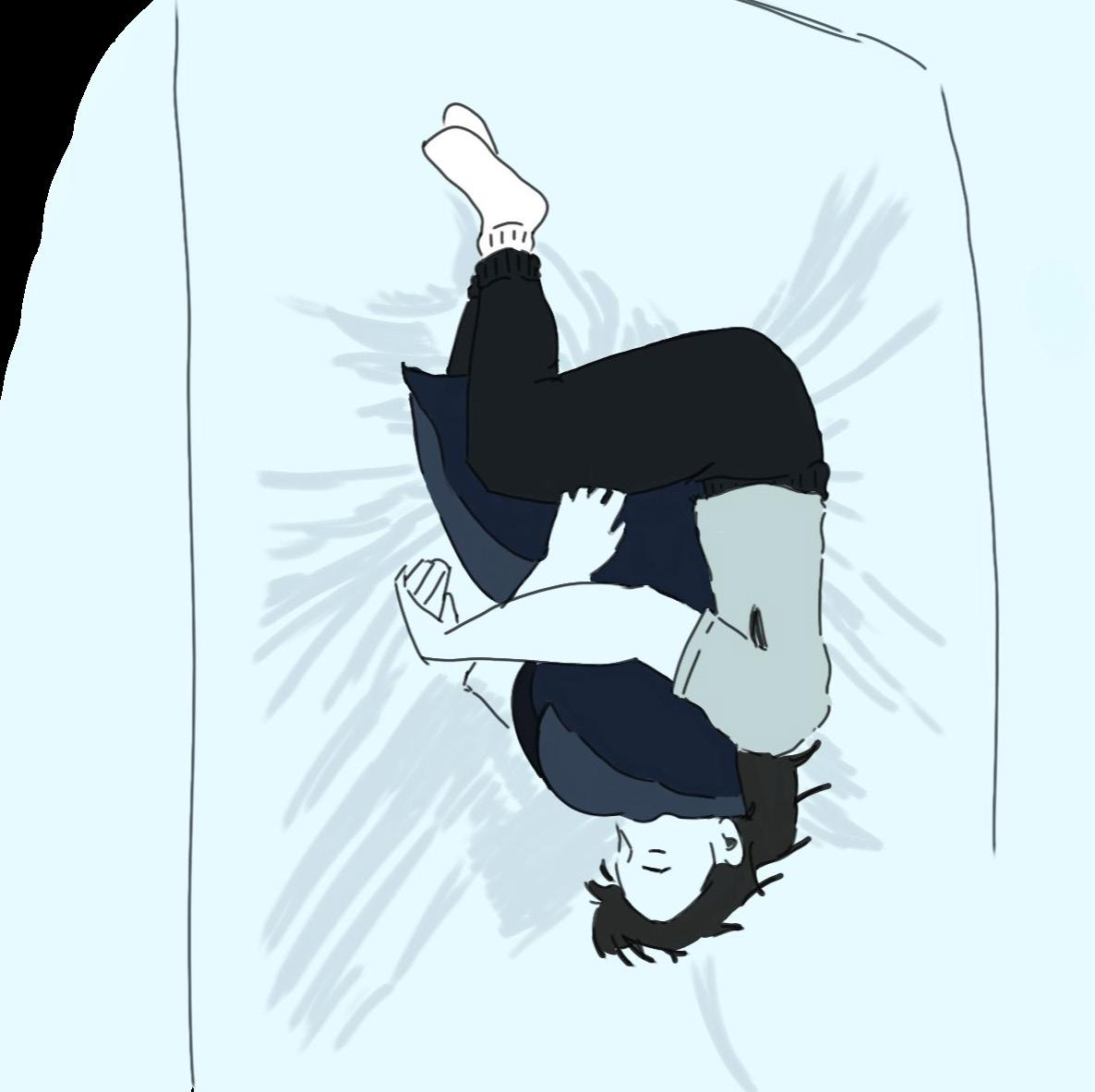
Like I am holding up, This very mountain that I am climbing on.
ARTWORK BY ALEXIS SANCHEZ, JUPITER, FLNever satisfied, the peak seems unreachable.
It’s too much.
“She’s the first in our family to go to college,”
My mother says proudly.
I cannot disappoint them. I cannot disappoint her. Who am I to take this opportunity for granted,
When there are people out there yearning for it?
So I go the extra mile, stay up later, and show the world.
That it is not too much.
I am stronger than ever, Realizing I can’t be perfect. I am ready to conquer new heights, With my dreams in mind.
I am making my family proud, But also making myself proud. I will reach the peak of this mountain,
And it is not too much.
BY EDNA BROWN, SHIRLEY, MAA simple four words can define your whole future
A simple four words define if you’re useful
You hold back your tears as your read down the page
Would they be ashamed, or would they be delighted?
That their own little kid has grown their own wings
But will they be cut down
And you’re left there to bleed
All that hard work, ultimately useless
It’s all come down to this
What we worked for from the day we were born
It’s the one little paper that decides your worth
You. Have. Been. Accepted
Never had you thought it’d lead up to this
The tears have spilled out by now
It has been decided, your place in society
What would your family and friends think if they knew of it Your failure
If...? You. Have. Been.
Denied.
Daily the packages pour in From all over the world. Hefty correspondences in thick, official envelopes
Announcing their provenance.
I pore over glossy brochures: Students smiling in front of ivy infested buildings, The august imagery creating an aching juxtaposition to My grim surroundings of crumbling buildings.
I daren’t venture outside my neighborhood.
I need to soar away like the jets that Nearly scrape my building. Take me to from whence they came
Daily the letters pour in From all over the world. Single sheets in thin, official envelopes
Announcing their provenance
Crumpling and discarding
The gentle, generic rebuffs, I await the transformative letter That will surely arrive.
The torrent reduced to a trickle, I watch with malice as the postman passes by. Only one letter remains outstanding. I daren’t open it when it arrives.
BY TITUS KIM, BRITISH COLUMBIA, CANADAmy built-in best friend no longer lives next door he begins his own life too far to knock between the walls
no longer lives next door word puns and silly walks go far away too far to knock between the walls the house is quiet and word puns and silly walks go far away too far to hear my voice call the house is quiet and I miss you
“MY BROTHER HAS BEEN AT MY SIDE ALL OF MY LIFE. HE LEFT FOR COLLEGE EARLIER THIS YEAR, AND I WANTED TO TRY TO EXPRESS WHAT HIS EMPTY ROOM FEELS LIKE TO ME AS I PASS BY IT EACH DAY. “
BY AVERY ROBINS, SAN FRANCISCO, CA BY ANONYMOUS ARTWORK BY ISABELLA VENANZI, JUPITER, FL
“MY SISTER IS LEAVING FOR COLLEGE, WHICH PROMPTED ME TO WRITE ABOUT IT AND THE STRESS SHE WENT THROUGH.”




Ella Snyder, 6
Chase Warchol, 8
Jackson Hummel, 14
Ethan Park, 16
Sean Pry, 18
Jason Skoog, 22
Anonymous, 24
Raven Morgan, 27
Anonymous, 28
Cassidy Watson, 32
Anonymous, 34
Carly Hytinen, 36
Sarah Zimmerman, 38
Allison Jackson, 38
Edna Brown, 38
Anonymous, 39
Titus Kim, 39
Avery Robins, 39
Anjani Lal, 10
Anonymous, 11
Lexie Vondrak, 12
Allison Liu, 20
Eva Lependorf, 20
Junxin Tang, 20
Logan Craine, 21
Noah Hawes, 21
Anna Song, 21
Caitlyn Kim, 21
Gugan Arumugam, 21
David Oladejo, 21
Robyn Davies, 30
Xichun Yuan, 31
Jaewon Kim, 31
Yincheng Qian, Front Cover
Ryan Agarwal, 9
Charlotte Kenyon, 9
Wenqian Wu, 9
Mele Barton, 9
Grace Wilcox, 11
Allison Liu, 13
Erin Enriquez, 13
Hannah Patrey, 13
Kaylie Ellers, 14
Anonymous, 16
Soeun Lee, 16
Antigone Stanley, 18
Lucy Liu, 22
Managing Editor: Noelle Campbell
Consulting Senior Editor: Cindy W. Spertner
Associate Editor: Kylie Andrews
Consulting Editor: Ashley Nix
Sales Account Executive: Sara Shuford
Ameera Barnes, 24 Katherine Zhao, 26 Caroline Schouten, 26
Zhihan Yang, 26
Anonymous, 27
Allison Liu, 28
Jiayin Zou, 29
Shrishti Gupta, 32
Seoyun Lee, 34
Dynali Forge, 36
Carlos Peters, 37
Ellie Brubaker, 37
Isabella Liu, 37
Jihye Yoo, 37
Alexis Sanchez, 38
Isabella Venanzi, 39
Antigone Stanley, 40
Stella Mccoy, 40
Bethan Powell, 40
Syna Gupta, 40
Samantha Cruz, Back Cover
